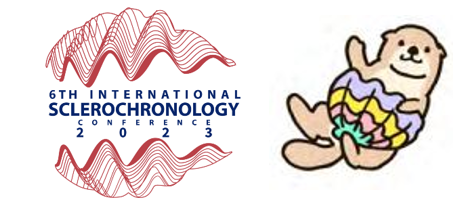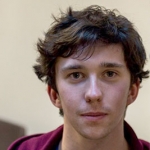Blog by 4D-Reef ESR Max Fursman, based at Goethe University Frankfurt, Germany
The scientific community is a vibrant tapestry of intellect, curiosity, and collaboration that spans across borders and unites researchers from all corners of the world. Among the myriad of scientific events that showcase this international camaraderie is the International Sclerochronology Conference.
The 6th ISC took place in Tokyo, Japan in May this year, as scientists from all over the globe either travelled or attended virtually to discuss all things sclerchronological (study of physical and chemical variations in the accretionary hard tissues of organisms).
I was representing 4D-Reef and Tridacna.
Usually the conference is held every 3 years but thanks to the pandemic the 6th sessions, which was due to take place in May 2022, was postponed by a year and a student run online conference was run instead.
After 19 hours and forty minutes of travel, or in other terms: 5 imodium-laced microwave-heated meals; 4 movies I had missed in cinemas; 3 hours of napping on a bench in Taipei airport cradling my laptop like a cabbage patch doll, I touched down in the Land of the Rising Sun.

I ate about a year’s worth of ramen in the few days before the conference…
The conference took place at the Hongo campus of the University of Tokyo, where in 1925 Prof. Hidesaburō Ueno died while lecturing. His loyal Akita dog Hachikō, who had learnt to wait for his owner to return at Shinuya station every day, continued to go and wait every day after his owner failed to return for nine years until he himself died… (Pass me the tissues)

Left: The banner proudly guiding us to the Yayoi Auditorium
Right – Top: Hongo Campus, University of Tokyo
Right – Bottom: the heartbreaking statue of Prof. Ueno and Hachikō
Hats off to the organising committee, let by Dr. Kotaro Shirai, as they did a truly superb job right from the get go.
Sunday evening we were welcomed to the meeting with an ice-breaker event where they had really pulled out all the stops. We were served a buffet of Japanese food, with opportunities to eat more mochi than the human body really should, sample Japanese wines and beers and were entertained by final year music students in what turned out to be a very entertaining, though somewhat cramped, evening that settled everyone comfortably in for the week.
The conference itself was a stupendous and ran smooth as silk.
The talks were a mixture of in person talks with some speakers joining via zoom from other countries, and covered topics from in depth sclerochemical analysis in fossil samples, to anthropology studies on shell remains in ancient middens.
Some of the keynote talks on biomineralisation, sclera-proxy development and evolutionary paleobiology were especially interesting. One in particular, delivered by Prof. Burchell from Memorial University’s Department of Archaeology, was thought provoking and resonated with a lot of those assembled. Entitled “Imagining a Radical Future for Archaeology and Sclerochronology”, the talk focused on the use of Indigenous and native groups to regions that are used for research or sample collection, and how their input into the studies should be taken on board and the culture and traditions respected and included as part of our work. It left a lot to think about and prompted some healthy discussion during the next break.
Speaking of, the coffee breaks were held in the poster area and yet again Kotaro et al came through with a variety of Japanese cakes and snacks available to sample and gorge on!

Left – top: The crowded ice-breaker event, with food galore and drinks flowing!
Left – bottom: the final day group photo!
Right – top: One very handsome sclerochronologist presenting his work on Tridacna sclerochemistry, representing 4D-Reef
Right – bottom: musicians playing for us during the ice-breaker
I was excited to present on my research, and spoke on a topic I had presented at ICRS last July, a long-term study into induced-seasonality in a tridacna sample. Since ICRS we have been able to expand our work into a greater depth and understanding and the chance to discuss it at a niche and specific conference where others would have intimate knowledge on the topic was a great opportunity. Myself and several others who study tridacna gathered afterwards to discuss our own work in depth and have since kept in contact and formed a slack group to trade ideas and promote further discourse on our sclerochemical endevours. While the virtual student ISC last September was interesting and engaging, the in person nature of a conference is something that cannot be replicated. These exchanges with people engaged in similar veins of work, and even those engaged in more general sclera-studies, have offered a chance to open up new avenues for collaboration and expanded my understanding of sclerochronology from various perspectives. The global nature of the conference facilitated interactions with scholars from different countries, fostering an enriching environment of cultural diversity and intellectual exchange.
Another treat organised by Kotaro et al was the conference dinner, which was a stupendous affair.
Held high up in Royal Park Hotel Tokyo we were treated to a buffet banquet overlooking Tokyo at night. Traditional foods, as well as Sake and beer, seemed to be in endless supply, with a tempura cooking display churning out fresh delicious snacks all evening.
The evening ended with a wonderful recital of traditional music on koto, the national instrument of Japan. It was mesmerizing to watch the skill and deft movements needed to pluck and tune this instrument and to charm such sweet melodies out.

Left – top: The musicians playing the traditional koto for us in a beautiful demonstration.
Left – bottom: a group of scientists standing round enjoying the food and drinks, one in particular wearing a VERY fetching batik shirt…
Right – top: the group photo following the meal
Right – bottom: the view from the dining room overlooking Tokyo at night
Beyond the confines of the conference halls, Tokyo unfolded as a captivating tapestry of cultural splendor. Each moment spent in the city was a sensory delight, offering an array of experiences that seamlessly blended ancient traditions with modern marvels. Any street could have simultaneously modern skyscrapers and stores, yet nestled within it is an untouched temple where the noise and bustle of the city seems to melt away. I found myself enthralled by the harmonious coexistence of serenity and dynamism that defined Tokyo.
We took our time to immerse ourselves in this new place, visiting temples, tourist attractions and trying our hand at karaoke!
One absolute highlight was a trip we took out to the coastal town of Enoshima, and the island just off the coast. Far from there, standing on the skyline, was the snow-capped peak of Mt. Fuji, piercing the sky with its grandeur. A slight fog added a mystic, ethereal haze to the scene, and the sheer beauty of the mountain seared itself into my mind.

Left –top: Me in front of Sensō-ji temple, Tokyo
Left – bottom: Iris finding Tridacna for sale at the beach. Sadly CITES might have taken issue to putting it in our carry-on…
Middle – top: Up in the hills at Kiyomizu-dera temple, Kyoto
Middle – middle: Inside the Torii tunnel on the mountain of Fushimi Inari-Taisha shrine
Middle – bottom: Mt. Fuji through the clouds, across the bay from Enoshima Island
Right – top: Meeting a celebrity at the Studio Ghibli shop (ignore the socks and shorts)
Right – bottom – quietly enjoying costume karaoke with my fellow conference attendees
What truly was a treat though, was Tokyo’s culinary scene. It proved to be a delight for the senses and I indulged in what can only be described as a gastronomic adventure in my spare time. Ramen, sushi, tempura, gyoza, I tried anything and everything I could. Some of it was unusual, such as the konjac, or devil’s tongue potato, which proved to have a tasty but fat/gelatin-like consistency when stewed. But everything was delicious and there is not one item I wouldn’t order again in a heartbeat.

A sampling of the food consumed on this trip
Overall, the journey from Frankfurt to Tokyo for the 6th International Sclerochronology Conference was an extraordinary experience that blended scientific exploration with cultural immersion. The conference itself proved to be a hub of knowledge, where ideas flowed freely, collaborations flourished, and new contacts made.
Beyond the academic sphere, Tokyo’s vibrant culture, awe-inspiring landmarks, and culinary wonders created a tapestry of experiences that left an indelible mark on my journey.
From presenting my research findings to engaging in stimulating discussions with experts in the field, I felt the conference fostered personal and professional growth. Tokyo, with its harmonious blend of tradition and innovation, captivated my senses, offering a glimpse into the rich cultural heritage of Japan, and I am grateful for the opportunities to learn, connect, and explore.

Sunset behind the main entrance Torii (sacred arch at shrine/temple entrances) at Fushimi Inari-Taisha shrine







